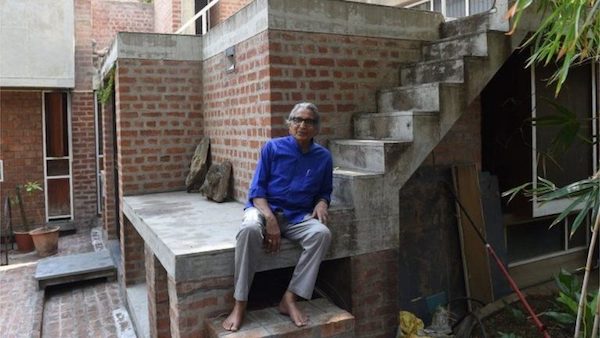
CHICAGO (TIP): Legendary Indian architect Balkrishna Doshi won the Pritzker Architecture Prize, which honors a living architect who has produced consistent and significant contributions to humanity and the built environment through the art of architecture.
The award, established by the Pritzker family of Chicago, is awarded each year to a legendary architect and is dubbed as “architecture’s Nobel”, the biggest honor for those working in this profession. The winners of the coveted award are architects whose built work demonstrates a combination of talent, vision, and commitment.
Doshi, 90, was born in Pune, India, to a family that had a history of furniture trade for two generations. He joined the Sir J.J. School of Architecture Bombay (Mumbai) in 1947 – the year India got its independence, to study architecture. The institute is the oldest and one of the foremost institutions for architecture in India.
With a dream of joining the Royal Institute of British Architects, he sailed to London and later to Paris to work with Le Corbusier.
Later he returned to India to oversee some of Le Corbusier’s projects in Chandigarh and Ahmedabad, which include the Mill Owner’s Association Building (Ahmedabad, 1954) and Shodhan House (Ahmedabad, 1956), among others.
Doshi also worked with Louis Kahn as an associate to build the Indian Institute of Management, Ahmedabad, and later started his own architectural firm by the name Vastushilpa with just two architects, which is now renamed as Vastushilpa Consultants. The firm now has five partners and sixty employees and has completed over 100 projects.
“My works are an extension of my life, philosophy and dreams trying to create treasury of the architectural spirit. I owe this prestigious prize to my guru, Le Corbusier. His teachings led me to question identity and compelled me to discover new regionally adopted contemporary expression for a sustainable holistic habitat,” Doshi said after he won the prize.
“Professor Doshi has said that ‘Design converts shelters into homes, housing into communities, and cities into magnets of opportunities,” the Pritzker jury said. “The life’s work of Balkrishna Doshi truly underscores the mission of the Prize—demonstrating the art of architecture and an invaluable service to humanity. I am honored to present the 40th anniversary of this award to an architect who has contributed more than 60 years of service to us all.”
Doshi has been recognized both within India and internationally. He is the recipient of the Officer of the Order of Arts and Letters of France (2011); Global Award for Lifetime Achievement for Sustainable Architecture, Institut Francais d’Architecture, Paris (2007); Prime Minister’s National Award for Excellence in Urban Planning and Design, India (2000); Aga Khan Award for Architecture (1993-1995) for Aranya Community Housing; Gold Medal, Academy of Architecture of France (1988); Gold Medal, Indian Institute of Architects (1988); and Padma Shree National Award, Government of India (1976).
Doshi is a Fellow of the Royal Institute of British Architects and the Indian Institute of Architects, and an Honorary Fellow of the American Institute of Architects. He served on the Pritzker Prize Jury from 2005 to 2007, and on selection committees for the Indira Gandhi National Centre for Arts and the Aga Khan Award for Architecture.
He has been a visiting professor at Massachusetts Institute of Technology; University of Pennsylvania, Philadelphia; University of Illinois, Urbana Champaign; Rice University, Houston; Washington University in St. Louis; and University of Hong Kong, among others, and has lectured at prestigious schools and institutions throughout the world.
Doshi was a member of the International Committee for preparing the International Charter on the Education of Architects, sponsored by International Union of Architects in association with UNESCO (1995), and holds honorary doctorates from the University of Pennsylvania, United States (1990) and McGill University, Canada (2005).





Be the first to comment